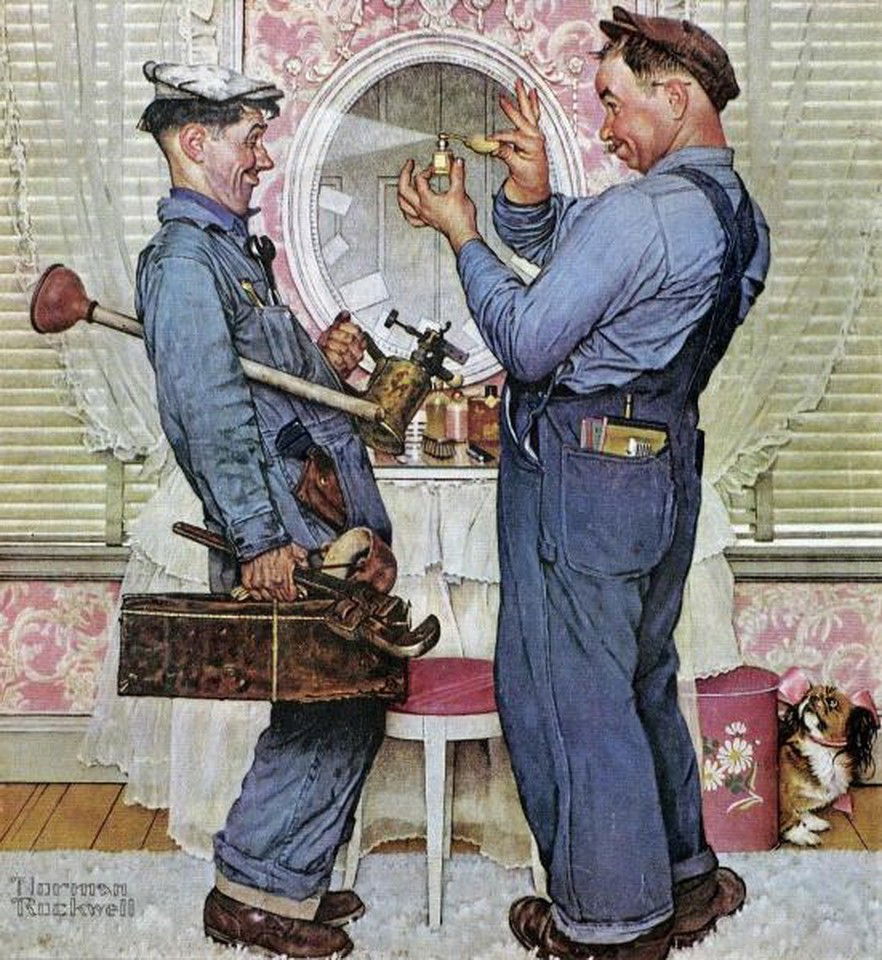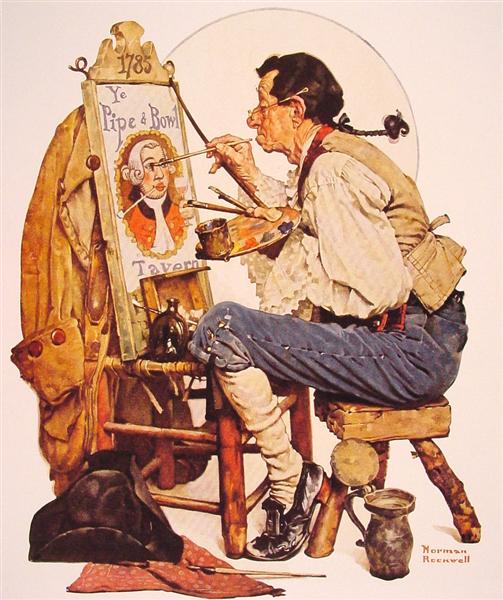Also see
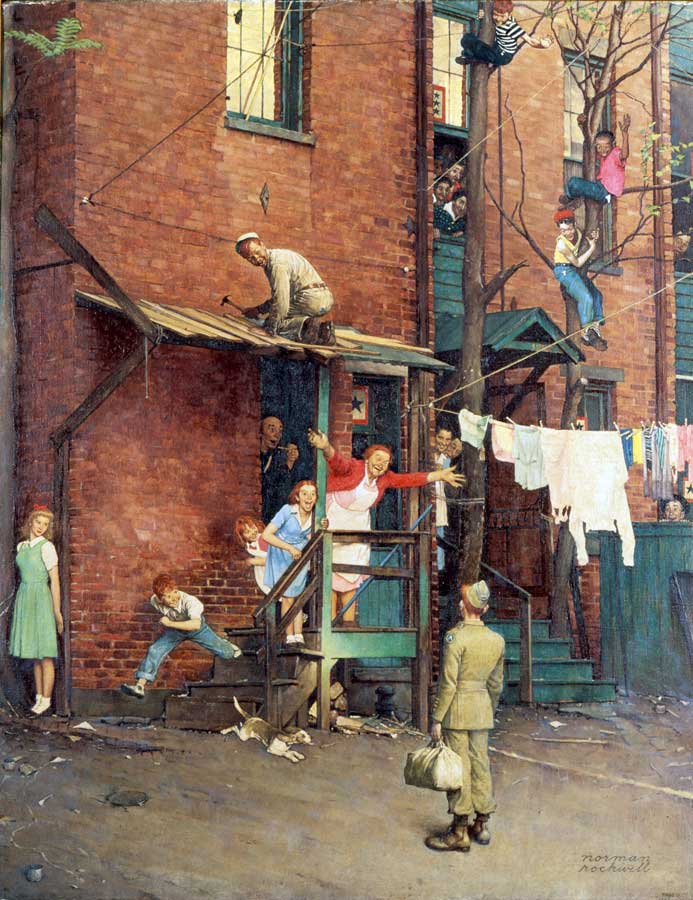
The top lot of the American Art sale is Norman Rockwell’s famed Saturday Evening Post cover The Homecoming, which was printed for the May 26, 1945 issue, just eighteen days after the end of World War II (estimate: $4,500,000–6,500,000). The timely and emotional image tells the story of a young soldier arriving home, where family, neighbors and even a love interest rush to greet him with ecstatic joy. The work was described by Post editor Ben Hibbs as “the finest cover Norman has done; in fact, I have always felt that it is the greatest magazine cover ever published.”
Sotheby’s spring auction of American Art will be held in New York on 23 May 2018. Led by 13worksby Norman Rockwell from all periods of the artist’s decades-long career, the sale features 120+ lots that are together estimated at more than $40million. The auction also includes exceptional example by Frederic Edwin Church, N.C. Wyeth, Milton Avery, Albert Bierstadt and Thomas Moran– many of which are from distinguished private collections and are coming to auction for the very first time.
NORMAN ROCKWELL: AMERICA’S FAVORITE STORYTELLER
Leading the selection of works by 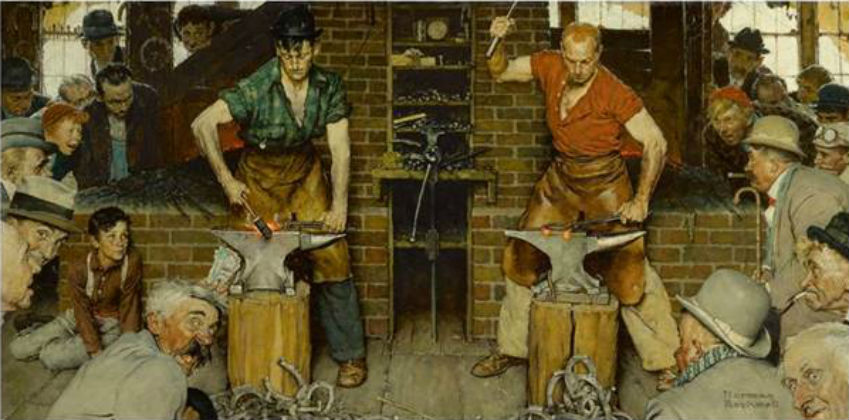
Norman Rockwell is Blacksmith’s Boy –Heel and Toe (Shaftsbury Blacksmith Shop), sold to benefit the Berkshire Museum in Pittsfield, Massachusetts (below, estimate $7/10 million). Commissioned for a 1940 The Saturday Evening Post story by Edward W. O’Brien, this monumental painting– measuring nearly six feet across –illustrates a horseshoe-forging contest, which O’Brien captured from the point of view of the local blacksmith’s son: “I’ll never forget that last hour. And never, I imagine, will any of those who watched. Both men were lost to everything now but the swing from the forge to the anvil, the heels to be turned and the toes to be welded.”
The drama of the competition is palpable as the two men captivate the growing crowd with their strength and skill. Working from photography and his own imagination, Rockwell exactingly depicts 23 figures in this impressive composition, including a self-portrait and two different representations of one of his favorite models, Harvey McKee –the undersheriff of the town of Arlington, Vermont.
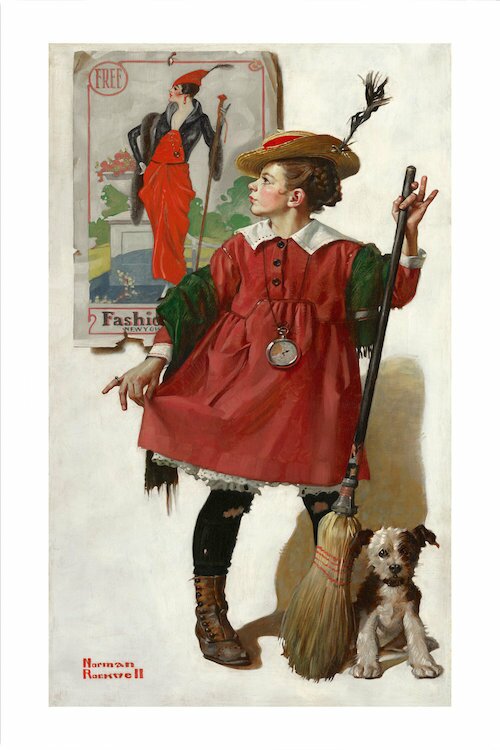
Another exceptional example by Norman Rockwell is The Little Model from 1919(estimate $1/1.5 million). A gift from the artist to his aunt that has remained in the family collection for nearly a century, the work was completed for the 29 March 1919 cover of Collier’s, making it one of Rockwell’s earliest images executed on commission for a prominent American publication. Rendered in the artist’s early style and technique, The Little Model brilliantly captures a young girl’s wistfulness and longing to transform into a beautiful adult, a detail highlighted when it appeared on Antiques Road Show in 2011.

Nearly forty years after the completion of Springtime comes Little Girl Looking Downstairs at Christmas Party, one of Rockwell’s most recognizable images. Painted for the cover of the December 1964 issue of McCall’s, the work depicts a forlorn young girl looking from the top of the stairs at the merry cocktail party taking place downstairs that she cannot join. A gift from the artist and being offered for the first time, this beloved image will be presented with a pre-sale estimate of $1/1.5 million.

Norman Rockwell is Blacksmith’s Boy –Heel and Toe (Shaftsbury Blacksmith Shop), sold to benefit the Berkshire Museum in Pittsfield, Massachusetts (below, estimate $7/10 million). Commissioned for a 1940 The Saturday Evening Post story by Edward W. O’Brien, this monumental painting– measuring nearly six feet across –illustrates a horseshoe-forging contest, which O’Brien captured from the point of view of the local blacksmith’s son: “I’ll never forget that last hour. And never, I imagine, will any of those who watched. Both men were lost to everything now but the swing from the forge to the anvil, the heels to be turned and the toes to be welded.”
The drama of the competition is palpable as the two men captivate the growing crowd with their strength and skill. Working from photography and his own imagination, Rockwell exactingly depicts 23 figures in this impressive composition, including a self-portrait and two different representations of one of his favorite models, Harvey McKee –the undersheriff of the town of Arlington, Vermont.

Another exceptional example by Norman Rockwell is The Little Model from 1919(estimate $1/1.5 million). A gift from the artist to his aunt that has remained in the family collection for nearly a century, the work was completed for the 29 March 1919 cover of Collier’s, making it one of Rockwell’s earliest images executed on commission for a prominent American publication. Rendered in the artist’s early style and technique, The Little Model brilliantly captures a young girl’s wistfulness and longing to transform into a beautiful adult, a detail highlighted when it appeared on Antiques Road Show in 2011.

Nearly forty years after the completion of Springtime comes Little Girl Looking Downstairs at Christmas Party, one of Rockwell’s most recognizable images. Painted for the cover of the December 1964 issue of McCall’s, the work depicts a forlorn young girl looking from the top of the stairs at the merry cocktail party taking place downstairs that she cannot join. A gift from the artist and being offered for the first time, this beloved image will be presented with a pre-sale estimate of $1/1.5 million.
NORMAN ROCKWELL’S CHRISTMAS HOMECOMING

A selection of three works by Norman Rockwell on offer include his preliminary study for the painting Christmas Homecoming, which appeared on the cover of the 25 December 1948 edition of The Saturday Evening Post (estimate $400/600,000). The work is the only image in the artist’s oeuvre in which all members of his immediate family appear and are portrayed as themselves. Rockwell's wife, Mary, embraces their eldest son, Jarvis, as he arrives home for the holidays with Christmas presents in hand, while the artist, his middle son Tom, and youngest son Peter appear in the background. Rockwell’s friends and fellow artists, Grandma Moses and Mead Schaeffer, are also rendered as family members. One of Rockwell's favorite models, Sharon O'Neil, appears twice as a set of twins in the immediate foreground.

A selection of three works by Norman Rockwell on offer include his preliminary study for the painting Christmas Homecoming, which appeared on the cover of the 25 December 1948 edition of The Saturday Evening Post (estimate $400/600,000). The work is the only image in the artist’s oeuvre in which all members of his immediate family appear and are portrayed as themselves. Rockwell's wife, Mary, embraces their eldest son, Jarvis, as he arrives home for the holidays with Christmas presents in hand, while the artist, his middle son Tom, and youngest son Peter appear in the background. Rockwell’s friends and fellow artists, Grandma Moses and Mead Schaeffer, are also rendered as family members. One of Rockwell's favorite models, Sharon O'Neil, appears twice as a set of twins in the immediate foreground.
Sotheby’s has unveiled the full offerings of our New York auction of American Art on 13 November 2017. Led by two masterworks by Norman Rockwell, sold to benefit the Berkshire Museum in Pittsfield, Massachusetts, the sale of 84 works of art represents the diversity of the American Art category, including strong examples of illustration, impressionist, modern and western art spanning the 19 th and 20 th centuries . The New York exhibition will be open to the public for 10 days, beginning 3 November.
NORMAN ROCKWELL
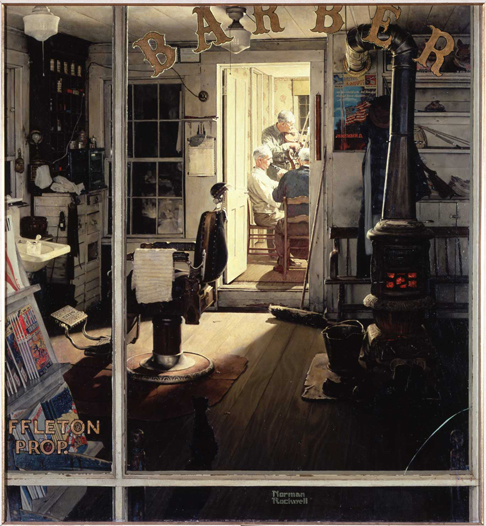
Shuffleton’s Barbershop © SEPS licensed by Curtis Licensing, Indianapolis, IN. All rights reserved.
The undisputed highlight of the November auction is Norman Rockwell’s Shuffleton’s Barbershop , one of the artist’s masterpieces, being sold to benefit the Berkshire Museum (below , estimate $20 /30 million). Painted in 1950 – at the height of Rockwell’s career and just one year prior to

Saying Grace, which holds the current auction record for the artist set at Sotheby’s in 2013 – the work is a visual testament to the full extent of Rockwell’s artistic abilities and incomparable imagination. Rockwell’s ambitious composition positions the viewer as the witness to the action taking place beyond the cracked plate -glass window of the storefront. His dramatic treatment of light – the golde n light that bathes the trio of musicians contrasts vividly with the shadows that blanket the rest of the closed- up shop – immediately captivates.
Further engaging is the variety of naturalistic details Rockwell includes to emphasize the authenticity and immediacy of the scene. When considered together, however, these minute elements – a World War II remembrance poster; a December 1949 issue of Walt Disney Comics and Stories ; a fishing rod a nd creel; the scroll of a cello – adopt a much more potent meaning.
At its core, Shuffleton’s Barbershop is the culmination of Rockwell’s investigation into the power of observation and the process of making art. Thus as he presents a subtle and unexpected marriage of high and popular culture, Rockwell asserts the idea that art can be found in the most unexpected of places or inde ed, that an illustrator can be a true artist.

Also selling to benefit from the Berkshire Museum is Blacksmith’s Boy – Heel and Toe (Shaftsbury Blacksmith Shop) by Norman Rockwell ( above , estimate $7/10 million). Monumental in size – measuring 70 1/4 inches across – the painting was commissioned for a story that appeared in a 1940 edition of The Saturday Evening Post about a horseshoe-forging contest, which included the following lines: “I’ll never forget that last hour. And never, I imagine, will any of those who watched. Both men were lost to everything now but the swing from the forge to the anvil, the heels to be turned and the toes to be welded.” The excitement of the narrative, articulated from the point of view of the local blacksmith’s son, is brilliantly portrayed by the two men who captivate the growing crowd with this demonstration of their strength and skill . Working from a series of photographs, which he exactingly orchestrated down to the last detail, Rockwell depicts a total of 23 figures in the composition , including a self - portrait and two different representation s of one of his favorite models, Harvey McKee, the undersheriff of the town of Arlington, Vermont.
QUINTESSENTIAL NORMAN ROCKWELL
Two Plumbers from 1951 is Norman Rockwell at his best. Created at the height of his career, the painting brilliantly demonstrates the artist’s talent for depicting everyday life with a dose of humor. To produce the current work, Rockwell employed two of his studio assistants – Don Winslow and Gene Pelham – as models, posing them in front of a dresser owned by his wife, Mary. By combining real-life models, who were often friends and neighbors of the artist, and photography, Rockwell was able to meticulously account for each and every detail, which is in part what brings his paintings to life. In his own words: “Now my pictures grew out of the world around me, the everyday life of my neighbors. I don’t fake it anymore”. Sold at Sotheby’s New York in 1996, and having remained in the same private collection since, Two Plumbers returns to the market this season with a pre-sale estimate of $5/7 million.
ILLUSTRATION ART
Study of Triple Self Portrait, 1960, (est. $150,000-250,000) is a superbly painted preparatory work for
what is certainly one of Norman's Rockwell's most iconic images. Here, the artist, with his back to the viewer and gripping his signature pipe, renders an idealized image of himself on canvas, providing an amusing contrast with his bespectacled reflection in the mirror.
The final painting, in permanent collection of the Norman Rockwell Museum, electrified the cover of the Feb. 13, 1960 Saturday Evening Post, which debuted the first installment of Rockwell's memoir, My Adventures as an Illustrator. The present study, executed in oil on photographic paper, originally was gifted to Rockwell's friend, Henry Strawn.
Sotheby’s New York 21 November auction of American Art . The sale is headlined by Norman Rockwell’s Saturday Evening Post cover, Which One? .The fall sale also includes strong examples of modernism by artists including Milton Avery and Charles Ephraim Burchfield, as well as Western art, which is well represented by Albert Bierstadt’s stunning Yosemite and four paintings formerly in the collection of Philadelphia sports owner and legend, Edward M. Snider. Following an exhibition in San Francisco and with several highlights on view during the Impressionist & Modern and Contemporary Art sale previews in New York, the full offerings of American Art will open to the public on 19 November.
Norman Rockwell’s Which One? (Undecided; Man in Voting Booth) will be a major highlight of our 21 November 2016 auction of American Art in New York. Depicting the public sentiment leading up to the presidential election of 1944 , in which President Franklin Delano Roosevelt ran against Thomas E. Dewey, this painting epitomizes Rockwell’s signature style , combining relatability and intellect, humour and all -American pride.
Acquired by the Phipps Family in the1980s , the painting will be exhibited in New York starting 4 November 2016 alongside Impressionist, Modern & Contemporary Art, before the American Art auction on 21 November, when it is estimated to sell for $4/6 million .
1944: AN ELECTION YEAR
Focused on the United States presidential election of 1944, a hotly -contested race between Democratic President Franklin Delano Roosevelt, running for his fourth term, and Republican Thomas E. Dewey, governor of New York, Which One? is a superb example of Norman Rockwell’s ability to highlight issues at the forefront of national discourse in a relatable manner. With questions of foreign and domestic policy, as well as the general health of the incumbent, being called into question, Americans rallied to vote, taking part in an essential, American experience. In Which One? a Cedar Rapids resident represents the millions of undecided voters across the country. Having educated himself with political pamphlets and newspapers, the former jammed in his pocket and the latter still grasped in his hand, the voter continues to weigh his options. While the image alone would have resonated with citizens throughout the United States, Norman Rockwell’s keen attention to detail, demonstrated by the fine print of The Cedar Rapids Gazette and the man’s bemused expression , bring s this undecided voter to life.
Furthermore, by balancing the composition and creating a sense of depth, one feels that he or she could step into the painting and into the shoes of the Cedar Rapids voter. Which One? (Undecided; Man in Voting Booth) embodies the best of Norman Rockwell and his ability to capture American life. Having been in the same collection for over three decades, the November auction of American Art offers a rare opportunity for collectors and institutions to acquire a quintessential work by one of America’s most beloved painters of the 20th Century.
NORMAN ROCKWELL: AMERICA’S STORYTELLER
Norman Rockwell was, and continues to be, America’s storyteller. Best known for his covers for The Saturday Evening Post, his works of art captured the zeitgeist of the day, including patriotism, racism and national security. In fact, with the public’s reliance on daily newspapers and weekly magazines like The Post for information and regular updates, his paintings were an integral part of the conversation. Capturing them with warmth, w it and a sense of humor, Norman Rockwell appealed to the average American. In the words of Thomas S. Buechner, “because [Rockwell] illustrates them using familiar people in familiar setting with wonderful accuracy, he continue to grow as new generations live through the same quintessentially American types of experiences that he so faithfully depicted in his art” (Norman Rockwell: A Sixty Year Retrospective, New York, 1972, p. 13).
Additional significant Rockwells on offer this November include
Pipe and Bowl Sign Painter (estimate $1.5/2.5 million )
Among the most sophisticated and complex compositions Rockwell created for the cover of The Saturday Evening Post, Road Block (estimate $4–6 million) demonstrates the artist’s distinctive sense of humor and unparalleled gift for storytelling–two of the qualities that have incited comparisons between Rockwell’s work and filmmaking. Regarding his 1949 painting Road Block, NormanRockwell bemoaned: “Why, oh, why do I paint such involved and complicated pictures?”
The May sale also will include Rockwell’s Hobo and Dog (estimate $1.5–2.5 million), sold by The Metropolitan Museum of Art. Appearing on the cover of The Post on October 18, 1924, it features one of Rockwell’s favorite models of the period: James K. Van Brunt.
American Art Auction on November 19
The top lot of the American Art auction on November 19, will be
Norman Rockwell Visits a Country Editor, estimated at $10-15 million. This major, large-scale work belongs to an important series of works Norman Rockwell completed for The Saturday Evening Post at the height of his career in 1946. The painting is being sold by the National Press Club Journalism Institute, with the approval of the National Press Club, and the proceeds from the sale will benefit both nonprofit organizations.
Norman Rockwell Visits a Country Editor appeared in the Saturday Evening Post on May 25, 1946. It was subsequently gifted to the National Press Club, an occasion later commemorated when Rockwell spoke at the Club on July 25, 1967. For the better part of the past seventeen years, the National Press Club Journalism Institute has kept the painting on public display in the space that it shares with the National Press Club in Washington, D.C. The work has also been loaned often and generously as part of the Club's stewardship, and most recently was on long-term loan to a museum.
Norman Rockwell Visits a Country Editor depicts a scene at the Monroe County Appeal, a small town newspaper founded in 1867 and located in Paris, Missouri. The painting is among Rockwell’s series of pictorial reports capturing the artist visiting various places, including a country school, the doctor, and the country editor. A highly complex composition, the work depicts nine characters, each uniquely articulated with Rockwell’s signature charm, bustling in the offices of the newspaper. The paper’s editor, Jack Blanton, is seated at the typewriter and at the far right of the composition Rockwell is seen striding through the door with his portfolio firmly wedged under his arm.
“This painting of a small-town America newsroom in the 20th Century will sustain the National Press Club and National Press Club Journalism Institute in our missions to support journalism for many more decades in the 21st Century,” said National Press Club President John Hughes, an editor for Bloomberg’s First Word. “The needs in the news profession are immense – from training those who have lost jobs to fighting for a free press worldwide. The sale of this great American artwork will help expand efforts to meet these needs at a critical time for our industry. What a great legacy for Norman Rockwell.”
“We are proud to offer this iconic work of art to the art market for consideration,” said Barbara Cochran, Chair of the Board of Directors of the painting’s owner, the National Press Club Journalism Institute, and the Curtis B. Hurley Chair in Public Affairs Journalism, University of Missouri School of Journalism. “At a time in which the noble tradition of community-based journalism is being challenged by societal and technological transformation, Norman Rockwell’s charming and realistic portrayal of a country editor and team of journalists diligently working to share news of the day with their community readers, epitomizes the attributes of American journalism and its contribution to the life of our nation.” Cochran added that proceeds of the sale will be used to support Institute programs to uphold press freedom, develop the skills of professional journalists and communicators, and provide scholarships for future journalists.
“By 1946, not only had Rockwell’s myriad covers of the Post captured the imagination of the nation, but the artist himself was becoming a celebrity in his own right,” comments Elizabeth Beaman, Christie’s Head of American Art. “Perhaps just as importantly, Rockwell’s work adopted a new sense of earnestness in order to more accurately reflect the realities that many faced in post-War America. While Rockwell’s classic sense of idealism remained intact, his imaginative images confronting issues of the present allowed the public to identify with his interpretation of life in America.”
